Yielding and early ripe eggplant variety "Bourgeois"
Several centuries ago, eggplant was mistaken for a poisonous vegetable. Due to the bitter taste of purple fruits, it was used only as an ornamental plant. Today, eggplant is grown on a personal plot and is actively eaten. This unusual vegetable is enriched with vitamins and minerals that the body needs to maintain immunity.
One of the best eggplants is Bourgeois. It is appreciated for its unusual round fruits and unpretentious care. Let's consider in more detail the description of the Bourgeois hybrid and photos of the fruits.
The content of the article
Description of eggplant Bourgeois
The Bourgeois hybrid appeared as a result of crossing several varieties... Due to this, it has increased resistance to diseases and pests, tolerates sudden changes in temperature, frost and rain.
Distinctive features
The hybrid is grown both in the greenhouse and in the open air... An early ripe vegetable ripens 105–110 days after planting. The bush is large, the foliage is dense. The plant reaches a height of 150–170 cm. Due to the abundance of fruits, the bush needs a garter, otherwise the stems will break under the weight of ripe eggplants.
Fruit characteristics and yield
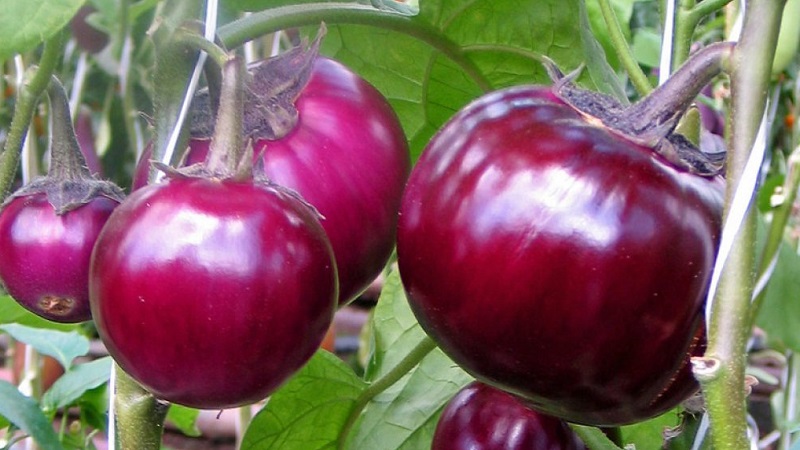
The fruits have a flattened round shape and a dark purple color with a glossy sheen... Eggplant weight varies from 400 to 600 g. The pulp is white, without bitterness, and the taste is tender. The yield is high, from 1 sq. m collect about 5 kg of juicy fruits.
Interesting! In the East, eggplant is called a longevity vegetable. Moderate consumption of the product improves the functioning of the circulatory system and promotes weight loss. 100 g of pulp contains only 28 kcal. The fiber in the fruit removes excess fluid from the body and contributes to weight loss. Thanks to the content of vitamin PP, eggplant helps to get rid of nicotine addiction.
How to grow eggplant yourself
Grow a hybrid seedling method... Seedlings help the seedlings adapt to external conditions and prevent disease.
Growing seedlings
Seedlings are prepared 2-3 weeks before planting eggplants on the site... This requires a seed container such as flower pots, plastic cups, or kefir boxes. The main thing before planting is to rinse the container and wipe it with a clean towel.
 Land from the garden is used as soil... It is cleaned of debris and weeds, heated in the oven for two hours at a temperature of +180 ° C. Many people prefer to use ready-made soil formulations from the store, since they are already disinfected in advance and enriched with nutrients for better plant development.
Land from the garden is used as soil... It is cleaned of debris and weeds, heated in the oven for two hours at a temperature of +180 ° C. Many people prefer to use ready-made soil formulations from the store, since they are already disinfected in advance and enriched with nutrients for better plant development.
Next, the planting material is disinfected by placing it in a solution of potassium permanganate for a day... The procedure kills dangerous microbes on the surface of the seeds and prevents diseases. After the inoculum is germinated by placing it in a damp gauze for 2-3 days. Germination improves germination.
Earth is poured into the container and small grooves are made with a depth of 1-2 cm... Two seeds are dipped into each, sprinkled with earth and gently slammed.
Water the seedlings with warm and clean water... Store in a warm and sunny place, for example, on a windowsill. If the windows face the north side, additional illumination with fluorescent lamps is arranged. Seedlings are watered once every 10 days. Fertilize twice with liquid organic fertilizers.5 days before planting in open ground, the seedlings are hardened - they are taken out to the balcony 3-4 hours daily.
Read also:
Transfer
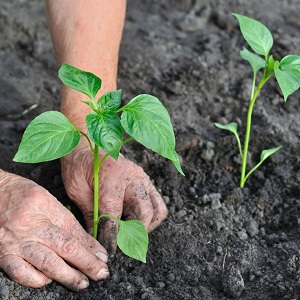 Eggplants are grown on fertile sandy loam soils... The beds are dug up, cleaned of the remains of last year's plants, and the grass and foliage are removed. The best predecessors for eggplant are cabbage, carrots, and beets. It is not recommended to plant the vegetable after potatoes or peppers. The soil is watered with liquid manure and river sand is added for looseness. The optimal size of the beds for the Bourgeois eggplant is 1000 × 30 cm.
Eggplants are grown on fertile sandy loam soils... The beds are dug up, cleaned of the remains of last year's plants, and the grass and foliage are removed. The best predecessors for eggplant are cabbage, carrots, and beets. It is not recommended to plant the vegetable after potatoes or peppers. The soil is watered with liquid manure and river sand is added for looseness. The optimal size of the beds for the Bourgeois eggplant is 1000 × 30 cm.
Transplant seedlings in open ground on a calm, cool day... For 1 sq. m place no more than 3 bushes. Water is poured into the prepared holes, then the seedlings are placed. Sprinkle the roots with earth and dry sawdust on top. The next watering will be organized in a week.
Important! If the bourgeois eggplant is planted in a greenhouse, the walls and doors are pre-wiped with the "Effecton" preparation. It destroys dangerous microbes and pathogenic microflora.
Further care
Water the beds as they dry... If the summer is hot and humid, the earth is moistened once every 7 days; in dry weather - every 5 days. Use warm water previously heated in the sun. Water the plants at the root, bypassing the stems and leaves. After rains and watering, the soil is loosened and weeds are removed. Such procedures improve microflora and oxygenate the soil. Eggplants are huddled every 2 weeks to strengthen the stems.
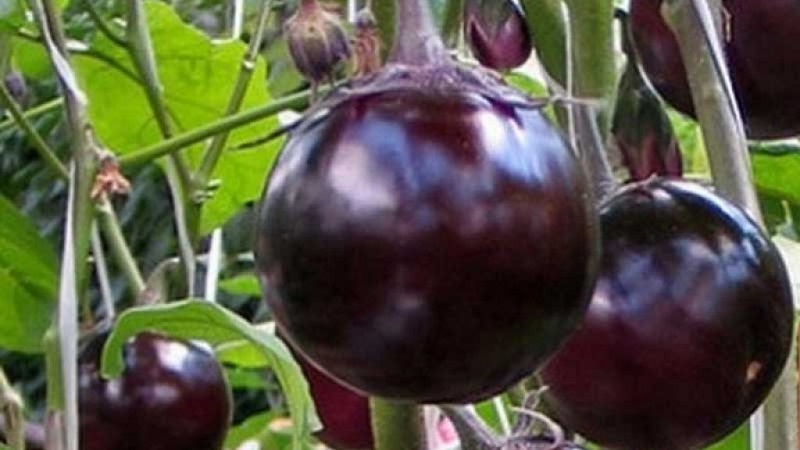
Particular attention is paid to organic and mineral feeding:
- 2 weeks after planting, the beds are watered with liquid manure or an ash solution. Organics improve the palatability of the fruit and prevent the appearance of insects.
- During the flowering period, plants are fertilized with superphosphate or potassium salt. Fertilizers are pre-dissolved in warm water.
- 3 weeks before harvest, the bushes are sprayed with soapy water or Bordeaux liquid to protect against diseases.
Features of cultivation and possible difficulties
If 4-5 fruits ripen on the bush at the same time, the plant is tied to a support... Near each eggplant, a wooden peg is driven into the ground, which is wiped with a solution of potassium permanganate in advance. The stems are tied neatly; the knots cannot be tightened strongly. After the formation of the first fruits, all side shoots are removed. During cultivation, the plants are regularly inspected for stains or other defects. Examinations help to detect diseases at an early stage and prevent their development.
Important! Thickened planting and lack of sunlight lead to the fact that the fruits do not gain purple color, but remain light.
Attention is also paid to mineral fertilizing. To avoid sunburn, they are applied only after watering.... Before use, summer residents carefully study the dosages and recommendations. An excess of potassium leads to leaf curling, and nitrogen - to an increase in green mass and slower fruit growth.
Diseases and pests
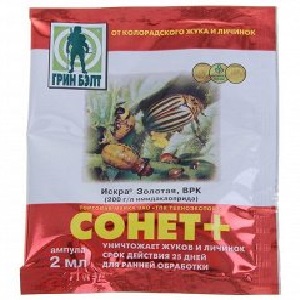 The most common eggplant disease is stolbur... Disease appears due to weeds or insects. Signs of a columnar: thickening of the stem, deformation of flowers, drying of leaves. As a preventive measure, seeds are disinfected and the rules of crop rotation are observed. For treatment, drugs "Actellik" or "Fitosporin" are used.
The most common eggplant disease is stolbur... Disease appears due to weeds or insects. Signs of a columnar: thickening of the stem, deformation of flowers, drying of leaves. As a preventive measure, seeds are disinfected and the rules of crop rotation are observed. For treatment, drugs "Actellik" or "Fitosporin" are used.
There is also tobacco mosaic on eggplant beds.... She is recognized by the white bloom, which becomes more and more over time. For prophylaxis, plants are sprayed with soapy water. In case of illness, infected bushes are eliminated from the beds and burned.
Eggplants are attacked by pests spider mite and aphids... Insects appear due to improper care, sudden changes in the weather, watering with cold water. Effective remedies against pests - drugs "Strela" and "Sonnet".In order to prevent it, the soil is loosened, weeds are removed and the rules for the introduction of organic and mineral dressings are observed.
Other varieties of eggplant:
Nutcracker review: advantages and disadvantages
Why is the Epic eggplant variety good and why it is worth growing
Harvesting and application of the crop
Bourgeois eggplant is harvested in August... Technical ripeness occurs 30–40 days after flowering. The fruits gain weight and rich color, become firm and elastic. Pick vegetables as they ripen. It is impossible to overexpose them on the bushes: the pulp loses its taste, becomes bitter. Cut the eggplants together with the stalk - this way they are stored longer.
Early maturing eggplant Bourgeois, therefore, the bulk of the harvest is eaten as early as possible. First of all, fruits with scratches or dents are processed. Eggplants are stored in a cool place for no more than 3 weeks.
Important! In the light, the vegetable produces solanine, an element dangerous to human health. Therefore, for storage, the crop is placed in dark plastic bags.
Due to its shape, the Bourgeois eggplant serves as an excellent base for stuffed baked dishes... The vegetable goes well with mushroom, vegetable and meat fillings. Its taste is emphasized by seafood, creamy sauces, dried fruits and spices. Housewives use the harvest for processing and harvesting useful winter preparations. Pickled and canned eggplants are in harmony with tomatoes, cucumbers and peppers. The appetizers are spiced up with garlic, a mixture of peppers, vinegar and a mixture of Provencal herbs.
Interesting! Eggplant is one of the main ingredients for the Italian spice pie. The recipe also includes minced meat, salted curd cheese, thyme, shallots. Such a pie is an excellent dish for a festive table.
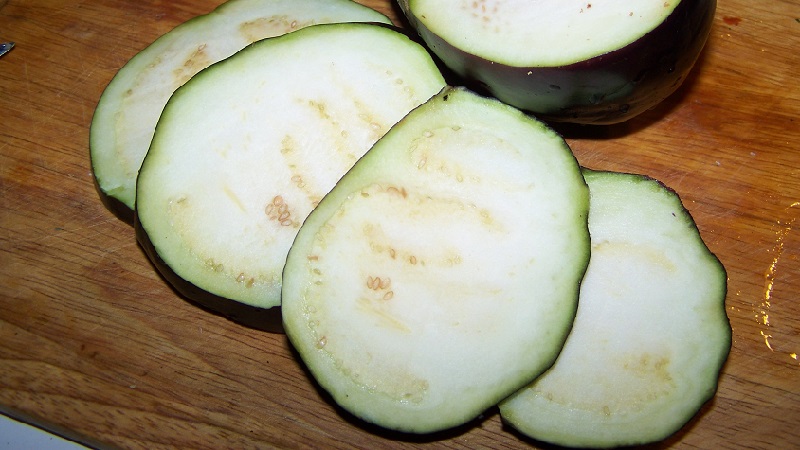
Advantages and disadvantages
The advantages of the hybrid include an attractive appearance of the fruit and tasty pulp.... Vegetable is used to prepare vitamin salads and winter preparations, side dishes and stuffed dishes. The plant is unpretentious in care, rarely gets sick, has immunity to insect pests. The hybrid shows a stable and high yield both in the open field and in greenhouse conditions.
Of the shortcomings, the need for a garter and the formation of a bush is noted... No more than three stepsons are left on one plant.
Reviews of experienced gardeners
Reviews about eggplant Bourgeois are mostly positive... However, sometimes there are neutral or negative comments.
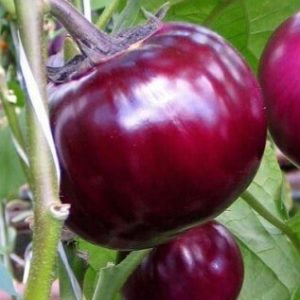 Victoria, Saratov: “I planted Bourgeois eggplant last year. The manufacturer's promises matched the result. The hybrid does not require much attention to itself, it is resistant to abrupt climatic changes. The taste of the fruit is soft, not bitter ".
Victoria, Saratov: “I planted Bourgeois eggplant last year. The manufacturer's promises matched the result. The hybrid does not require much attention to itself, it is resistant to abrupt climatic changes. The taste of the fruit is soft, not bitter ".
Olga, Moscow: “The bushes grew up to 1.5 m, a month later I tied them to a support. The fruits were tied together, the return is excellent. Fertilized with liquid manure and ammonium nitrate. Used for cooking baked dishes and stuffed with meat filling ".
Igor, Oryol: “Bourgeois eggplant attracted with its round fruits. I planted it in a greenhouse, expecting to get large vegetables. However, the maximum weight of the fruit reached only 300 g. I looked after regularly, what is the reason for the poor harvest - I do not know. Perhaps it's the soil. ".
Conclusion
Purple vegetables will brighten up any garden plot. Especially if they have an original shape and a pleasant taste. Bourgeois, as befits a hybrid, is resistant to major diseases of the culture. It is planted after cabbage or carrots, on fertile and loose beds. The treatment consists of traditional procedures: watering, fertilizing and loosening.
Organic matter (manure, ash, dung) and minerals (superphosphate, potassium salt, ammonium nitrate) help to get a tasty harvest. Fruits are harvested 3 months after planting. Eggplants do not last long, it is best to eat them or process them within 2-3 weeks.